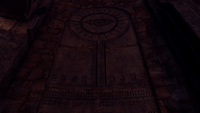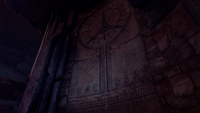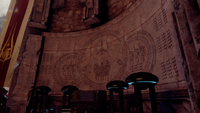Covenant religion: Difference between revisions
From Halopedia, the Halo wiki
(Overhaul for flow/objectivity (Unfinished)) |
(Overhaul part 2 (unfinished)) |
||
| Line 15: | Line 15: | ||
===Conflict and spread=== | ===Conflict and spread=== | ||
While the exact date remains unrecorded, the Ages of Conflict spanned | While the exact date remains unrecorded, the Ages of Conflict spanned thousands of years and were a significant period in the spreading of what started out as solely the San'Shyuum's Faith (and by extension, their empire). In the First Age of Conflict, the San'Shyuum Reformists eventually encountered a saurian species known as the [[Sangheili]]. This alien race had developed a Religion based on the worship of Forerunner deities independently of the San'Shyuum. However, while the two species shared similar religious beliefs, the Sangheili believed that tampering with the artifacts of their gods was an unforgivable offense. Their first contact soon led to the [[San'Shyuum-Sangheili War]]. The war ended with the submission of the Sangheili and the formation of a new empire through the [[Writ of Union]]. The Sangheili would take the role as the warriors, with the San'Shyuum acting as their superiors in matters of technology and faith, advising their allies on how best to achieve the Great Journey. | ||
===Development and rebellion=== | ===Development and rebellion=== | ||
[[File:H2Aterm-Sesa and GS 3.jpg|thumb|200px|Sesa 'Refumee, the leader of the [[Heretics]] with [[343 Guilty Spark]] at his side.]] | [[File:H2Aterm-Sesa and GS 3.jpg|thumb|200px|Sesa 'Refumee, the leader of the [[Heretics]] with [[343 Guilty Spark]] at his side.]] | ||
{{quote|Ask the Oracle about Halo...how they would sacrifice us all for nothing!|[[Sesa 'Refumee]] to the [[Thel 'Vadam|Arbiter]].}} | {{quote|Ask the Oracle about Halo...how they would sacrifice us all for nothing!|[[Sesa 'Refumee]] to the [[Thel 'Vadam|Arbiter]].}} | ||
The development of the Covenant religion | The development of the Covenant religion took place across seven ages; the [[Age of Abandonment]], [[Ages of Conflict]], [[Ages of Reconciliation|Age of Reconciliation]], [[Ages of Discovery|Age of Discovery]], [[Ages of Conversion|Age of Conversion]], [[Ages of Doubt]] and the [[Ages of Reclamation]]. These ages saw the expansion of the Empire's power and the belief in the Great Journey throughout its new vassal races. In [[784 BCE]], The [[Lekgolo]] became the next species to submit to the Covenant religion after the Sangheili. They were followed in [[1342 CE]] By the [[Kig-Yar]] (though most were influenced by monetary rewards granted by the San'Shyuum). Next, in [[2142 CE]], came the [[Unggoy]]. The [[Jiralhanae]], in [[2492 CE]], were the last species to be fully integrated into the Covenant Empire, and thus their Religion. | ||
The Covenant religion was not entirely without internal conflicts and heretical movements; in the | The Covenant religion was not entirely without internal conflicts and heretical movements; in the final days of the Covenant Empire's rule, there was a [[Heretics|Heretic uprising]] on [[Threshold Gas Mine|Threshold]], near [[Installation 04|Alpha Halo]]. An [[Arbiter]], [[Thel 'Vadam|Thel 'Vadamee]], was sent with a strike force to deal with the threat. | ||
It is currently unknown whether or not there were similar uprisings earlier in the Covenant's history. | It is currently unknown whether or not there were similar uprisings earlier in the Covenant's history. | ||
===The rise and fall=== | ===The rise and fall=== | ||
{{quote|In a moment, I will light the rings! And all who believe... shall be saved!|The Prophet of Truth}} | {{quote|In a moment, I will light the rings! And all who believe... shall be saved!|The Prophet of Truth}} | ||
The Covenant religion reached its zenith when [[Fleet of Particular Justice | The Covenant religion reached its zenith when the [[Fleet of Particular Justice]] discovered [[Installation 04]] by accident, chasing the [[UNSC Pillar Of Autumn]] from [[The Fall Of Reach|Their victory]] at [[Reach]]. This unexpected discovery led to the immediate presence of the holy city [[High Charity]] and its accompanying fleet. However, efforts to ignite the ring were prevented by [[John-117]], who destroyed the Ring in order to stop the release of [[The Flood]]. This percieved sacrilege ignited widespread anger and grief among the ranks of the Covenant, having come so close to the fulfillment of their Great Journey. | ||
The High Prophet of Truth was aware of this fact and left early before the UNSC intervened | Only a month later, [[Installation 05]] was discovered when the [[Prophet of Regret|High Prophet of Regret]] made a slipspace journey to the [[Coelest system]]. However, the Covenant was once again denied in their efforts. The Master Chief and a small force of humans from the [[UNSC ''In Amber Clad'']] made their way onto the Ring and killed the Prophet in order to stop him from activating it.In response, the fleet glassed the temple from where Regret had been giving a sermon, though the Master Chief escaped. [[Prophet of Truth|The Prophet of Truth]] used Regret's death as an excuse to initiate the [[Changing of the Guard]], the first step in his plot to remove the Sangheili from the Covenant. This, and the subsequent orders for the Sangheili to be exterminated, culminated in the [[Great Schism]]. The humans from ''In Amber Clad'', in conjunction with a force of Sangheili led by Thel 'Vadamee and [[Rtas 'Vadumee|Rtas 'Vadum]], were also successful in stopping [[Tartarus]] in his efforts to activate the Ring while the battles of the Schism raged around them. Though Installation 05 was not destroyed in its emergency shutdown, the entire Halo Array was automatically moved to standby status in preperation for firing from [[Installation 00|The Ark]]. | ||
The High Prophet of Truth was aware of this fact and left High Charity early, before the UNSC intervened in Installation 05's firing. During the Covenant invasion of Earth, Truth had his fleet excavate [[The Portal]], which would enable him and his fleet to journey towards the Ark. The UNSC along with its newfound allies, the [[Fleet of Retribution|Sangheili]], traveled to the Ark to do battle with the Prophet-allied forces. The humans were successful, destroying the path to the Ark and removing the threat of the Halo Array. | |||
===Post-Schism=== | ===Post-Schism=== | ||
Following the Great Schism and the death of the Prophet of Truth, the Covenant effectively dissolved. For more than six years, the member species of the Covenant fought a brutal civil war. Immediately following Truth's death, the San'Shyuum sought to save themselves from the rage of the Sangheili, and so provided the Jiralhanae with new weapons, ships and other tools to aid in their protection. During this period the Prophets, who already had been few in number, largely disappeared, leading to rumors that they had actually finally achieved the Great Journey.<ref name="return500s">'''[[Halo: Evolutions - Essential Tales of the Halo Universe]]''', "[[The Return]]", ''pages 506-507''</ref> | Following the Great Schism and the death of the Prophet of Truth, the Covenant--and the organisation of their religion--effectively dissolved. For more than six years, the member species of the Covenant fought a brutal civil war. Immediately following Truth's death, the San'Shyuum sought to save themselves from the rage of the Sangheili, and so provided the Jiralhanae with new weapons, ships and other tools to aid in their protection. During this period the Prophets, who already had been few in number, largely disappeared, leading to rumors that they had actually finally achieved the Great Journey.<ref name="return500s">'''[[Halo: Evolutions - Essential Tales of the Halo Universe]]''', "[[The Return]]", ''pages 506-507''</ref> | ||
Even amongst the [[Covenant remnants]] their belief in the Forerunners as gods was not completely abandoned, but rather the Schism marked a return to more ancient systems of belief. As one [[Unidentified Sangheili Shipmaster (The Return)|Sangheili Shipmaster]] believed, "he knew his gods were out there, but he had no idea what they wanted."<ref name="return500s"/> Members of the Covenant had relied on the Prophets to lead them in spiritual matters. The devout Sangheili in particular had not had any need for their own religious leaders for centuries, and now found that few among them had the knowledge or the ability to comprehend the will of the gods. For a people whose sole purpose had been enforcing their gods' will, this was a terrifying prospect. | Even amongst the [[Covenant remnants]] their belief in the Forerunners as gods was not completely abandoned, but rather the Schism marked a return to more ancient systems of belief. As one [[Unidentified Sangheili Shipmaster (The Return)|Sangheili Shipmaster]] believed, "he knew his gods were out there, but he had no idea what they wanted."<ref name="return500s"/> Members of the Covenant had relied on the Prophets to lead them in spiritual matters. The devout Sangheili, in particular, had not had any need for their own religious leaders for centuries, and now found that few among them had the knowledge or the ability to comprehend the will of the gods. For a people whose sole purpose had been enforcing their gods' will, this was a terrifying prospect. | ||
While the Covenant religion itself was more or less defunct, worship of the Forerunners among the Sangheili persisted into the post-war era. The [[Servants of the Abiding Truth]], a group of Sangheili fundamentalists, continued to uphold their species' pre-Covenant religious beliefs and took aggressive action against the secular regime spearheaded by Thel 'Vadam. [[Jul 'Mdama's Covenant faction|Another group]], led by former Covenant shipmaster [[Jul 'Mdama]], also | While the Covenant religion itself was more or less defunct, worship of the Forerunners among the Sangheili persisted into the post-war era. The [[Servants of the Abiding Truth]], a group of Sangheili fundamentalists, continued to uphold their species' pre-Covenant religious beliefs and took aggressive action against the secular regime spearheaded by Thel 'Vadam. [[Jul 'Mdama's Covenant faction|Another group]], led by former Covenant shipmaster [[Jul 'Mdama]], also continued to revere the Forerunners as gods, and sought out the [[Ur-Didact|Didact]] on the Shield World [[Requiem]] in order to ask for his aid in destroying humanity. | ||
His efforts were successful, and the Didact awoke with the goal of [[Composer|Composing humanity]]. John-117 and the [[UNSC Infinity|UNSC ''Infinity'']] had both arrived at Requiem, however, and managed to stop him. | |||
==Articles of faith== | ==Articles of faith== | ||
Revision as of 19:09, July 19, 2017
| This article does not have enough inline citations and/or does not adhere to the proper citation format. You can help Halopedia by adding citations. |
- "Every member of the Covenant shall walk the Path. None will be left behind when our Great Journey begins! That is the Prophets' age-old promise, and it shall be fulfilled!"
- — The Prophet of Regret[1]
The Covenant was founded on and united by a single religion, based upon the worship of the ancient race of beings known as the Forerunners. The Covenant commonly referred to the religion and its teachings as the Path.[1][2]
Background
According to the Covenant religion, the Forerunners, a race of enlightened beings regarded as nearly omniscient and all-powerful, discovered a way to transcend the physical world and became divine gods by activating the Halos, or "Sacred Rings" as referred to by members of the Covenant.[3] The Halos supposedly uplifted the Forerunners into transsentience, but left all lesser, unworthy races behind. The Covenant believed themselves to be the chosen inheritors of the Forerunners, and sought to reclaim the "gifts" they left behind, in most cases lost technology. Their ultimate goal was to locate and activate the Halo installations. In doing so, it was believed that all faithful adherents to the Covenant religion would be uplifted as the Forerunners were, following them on a Great Journey resulting in godhood. This belief was shared, with varying degrees of sincerity, amongst all the Covenant's client races.
History
Reformists and Stoics
What would eventually become the Covenant religion was first practiced on Janjur Qom, the San'Shyuum homeworld. Janjur Qom was home to two influential factions, the Stoics and the Reformists. Although both factions believed in the prophecy of ascendancy and the holiness of artifacts left behind by their gods, they held different views on how the religion should be practiced; the Reformists believed that the religion could spread throughout the galaxy through travel in their lords' ship--a Forerunner Keyship that had reseeded Janjur Qom with San'Shyuum millennia earlier, unbeknownst to the populace--but the Stoics viewed their actions as desecrating the memory of the Forerunners. This initiated the San'Shyuum Schism, a conflict which resulted in the defeat of the Stoics. The Reformists used the Keyship to leave Janjur Qom, traveling through the stars in search of more Forerunner Relics.
Conflict and spread
While the exact date remains unrecorded, the Ages of Conflict spanned thousands of years and were a significant period in the spreading of what started out as solely the San'Shyuum's Faith (and by extension, their empire). In the First Age of Conflict, the San'Shyuum Reformists eventually encountered a saurian species known as the Sangheili. This alien race had developed a Religion based on the worship of Forerunner deities independently of the San'Shyuum. However, while the two species shared similar religious beliefs, the Sangheili believed that tampering with the artifacts of their gods was an unforgivable offense. Their first contact soon led to the San'Shyuum-Sangheili War. The war ended with the submission of the Sangheili and the formation of a new empire through the Writ of Union. The Sangheili would take the role as the warriors, with the San'Shyuum acting as their superiors in matters of technology and faith, advising their allies on how best to achieve the Great Journey.
Development and rebellion
- "Ask the Oracle about Halo...how they would sacrifice us all for nothing!"
- — Sesa 'Refumee to the Arbiter.
The development of the Covenant religion took place across seven ages; the Age of Abandonment, Ages of Conflict, Age of Reconciliation, Age of Discovery, Age of Conversion, Ages of Doubt and the Ages of Reclamation. These ages saw the expansion of the Empire's power and the belief in the Great Journey throughout its new vassal races. In 784 BCE, The Lekgolo became the next species to submit to the Covenant religion after the Sangheili. They were followed in 1342 CE By the Kig-Yar (though most were influenced by monetary rewards granted by the San'Shyuum). Next, in 2142 CE, came the Unggoy. The Jiralhanae, in 2492 CE, were the last species to be fully integrated into the Covenant Empire, and thus their Religion.
The Covenant religion was not entirely without internal conflicts and heretical movements; in the final days of the Covenant Empire's rule, there was a Heretic uprising on Threshold, near Alpha Halo. An Arbiter, Thel 'Vadamee, was sent with a strike force to deal with the threat. It is currently unknown whether or not there were similar uprisings earlier in the Covenant's history.
The rise and fall
- "In a moment, I will light the rings! And all who believe... shall be saved!"
- — The Prophet of Truth
The Covenant religion reached its zenith when the Fleet of Particular Justice discovered Installation 04 by accident, chasing the UNSC Pillar Of Autumn from Their victory at Reach. This unexpected discovery led to the immediate presence of the holy city High Charity and its accompanying fleet. However, efforts to ignite the ring were prevented by John-117, who destroyed the Ring in order to stop the release of The Flood. This percieved sacrilege ignited widespread anger and grief among the ranks of the Covenant, having come so close to the fulfillment of their Great Journey.
Only a month later, Installation 05 was discovered when the High Prophet of Regret made a slipspace journey to the Coelest system. However, the Covenant was once again denied in their efforts. The Master Chief and a small force of humans from the UNSC ''In Amber Clad'' made their way onto the Ring and killed the Prophet in order to stop him from activating it.In response, the fleet glassed the temple from where Regret had been giving a sermon, though the Master Chief escaped. The Prophet of Truth used Regret's death as an excuse to initiate the Changing of the Guard, the first step in his plot to remove the Sangheili from the Covenant. This, and the subsequent orders for the Sangheili to be exterminated, culminated in the Great Schism. The humans from In Amber Clad, in conjunction with a force of Sangheili led by Thel 'Vadamee and Rtas 'Vadum, were also successful in stopping Tartarus in his efforts to activate the Ring while the battles of the Schism raged around them. Though Installation 05 was not destroyed in its emergency shutdown, the entire Halo Array was automatically moved to standby status in preperation for firing from The Ark.
The High Prophet of Truth was aware of this fact and left High Charity early, before the UNSC intervened in Installation 05's firing. During the Covenant invasion of Earth, Truth had his fleet excavate The Portal, which would enable him and his fleet to journey towards the Ark. The UNSC along with its newfound allies, the Sangheili, traveled to the Ark to do battle with the Prophet-allied forces. The humans were successful, destroying the path to the Ark and removing the threat of the Halo Array.
Post-Schism
Following the Great Schism and the death of the Prophet of Truth, the Covenant--and the organisation of their religion--effectively dissolved. For more than six years, the member species of the Covenant fought a brutal civil war. Immediately following Truth's death, the San'Shyuum sought to save themselves from the rage of the Sangheili, and so provided the Jiralhanae with new weapons, ships and other tools to aid in their protection. During this period the Prophets, who already had been few in number, largely disappeared, leading to rumors that they had actually finally achieved the Great Journey.[4]
Even amongst the Covenant remnants their belief in the Forerunners as gods was not completely abandoned, but rather the Schism marked a return to more ancient systems of belief. As one Sangheili Shipmaster believed, "he knew his gods were out there, but he had no idea what they wanted."[4] Members of the Covenant had relied on the Prophets to lead them in spiritual matters. The devout Sangheili, in particular, had not had any need for their own religious leaders for centuries, and now found that few among them had the knowledge or the ability to comprehend the will of the gods. For a people whose sole purpose had been enforcing their gods' will, this was a terrifying prospect.
While the Covenant religion itself was more or less defunct, worship of the Forerunners among the Sangheili persisted into the post-war era. The Servants of the Abiding Truth, a group of Sangheili fundamentalists, continued to uphold their species' pre-Covenant religious beliefs and took aggressive action against the secular regime spearheaded by Thel 'Vadam. Another group, led by former Covenant shipmaster Jul 'Mdama, also continued to revere the Forerunners as gods, and sought out the Didact on the Shield World Requiem in order to ask for his aid in destroying humanity. His efforts were successful, and the Didact awoke with the goal of Composing humanity. John-117 and the UNSC Infinity had both arrived at Requiem, however, and managed to stop him.
Articles of faith
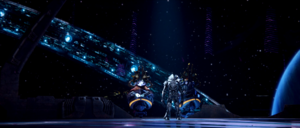
The Great Journey
The Great Journey is the central goal of the Covenant religion. According to the Covenant, the Forerunners initiated the first Great Journey through the use of the seven Halos, or sacred rings, which unleashed a "divine wind" that swept through the galaxy and elevated the Forerunners to godhood. The Covenant seeks to do the same by finding and activating the sacred rings, which would transcend those worthy to the divine beyond, a heavenly paradise they will share with the Forerunners. The non-believers and those unworthy of the journey would be left behind, as punishment for their heresy.
In addition to being their overall goal, the Covenant also employ the term "Great Journey" in a broader sense; as an expression of the path to transcendence, both collectively and individually. For example, a Sangheili warrior's individual "Great Journey" is said to start when they first begin their training.[5]
The Mantle
- Main article: Mantle
The Covenant are aware of the Forerunner concept of the Mantle, although they appear to misunderstand its true meaning.[6] Whereas the Forerunners' Mantle was their responsibility to protect and watch over all life in the galaxy, the Covenant regard the Mantle as their divine right to inherit dominion over the galaxy, namely through following in the footsteps of their gods.
The Halo Array
- Main article: Halo Array
The Halos, otherwise referred to as "Sacred Rings" or "Holy Rings"[7] by members of the Covenant, were seven holy artifacts that, when activated, would propel all "worthy" individuals in the galaxy into a heavenly paradise, where they would exist as divine beings. This could only be achieved by the retrieval of the "Sacred Icon", a holy artifact that would activate the rings.
From the inception of the Covenant religion, the Covenant Empire scoured all known star systems within their reach, relentless in finding at least one of these Sacred Rings. The search for the rings spanned over seven Ages; the Age of Reclamation was the age in which the Covenant finally came into contact of two Sacred Rings. The first contact was short-lived, as the first Halo was destroyed by a demon, while the firing of the second was stopped due to Sangheili defectors who teamed up with the UNSC.
In the event that a Holy Ring was to be discovered, a reclamation procedure had to be followed under San'Shyuum leadership. This was known as the "Consecration".[8] The only individual who oversaw such a procedure was the Prophet of Stewardship, though he was unsuccessful due to the first Ring's destruction.
The Parasite
- Main article: Flood
The Flood, or "The Parasite" as referred to by members of the Covenant, are an unholy, virulent species regarded as one of many tests and obstacles that the believers of the Covenant must conquer in order to achieve the Great Journey. According to the Covenant, the Flood were vanquished by the Forerunners long ago, and were purged from existence when the Great Journey commenced. The latter was later revealed to be false, however, when the Flood reappeared on one of the Sacred Rings.
The Governors of Contrition, a radical sect within the Covenant religion, believed the Flood to be Forerunner creations and therefore sacred. Their views were not widely accepted, however.
Oracles
- Main article: Monitor
The Covenant refer to all Forerunner AIs as "Oracles". They believe these constructs to hold holy knowledge regarding the Great Journey, and hold their words as sacred truths. Mendicant Bias and the Monitors are all regarded as oracles by the Covenant.
The Arbiter
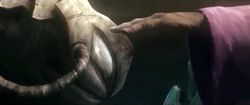
- Main article: Arbiter
- "Here rest the vanguard of the Great Journey, every Arbiter from first to last. Each one created and consumed in times of extraordinary crisis."
- — The Prophet of Truth to the Arbiter.
Arbiter is a traditional and religious title held by a Sangheili in times of great distress and pressure. An Arbiter would only be required to undertake tasks given out by the High Prophets and would be expected to sacrifice their life for the advancement of the Covenant and achievement of the Great Journey. The title of Arbiter was once given to the commander of the Sangheili military, and was regarded as a great honor; after the heresy of Arbiter Fal 'Chavamee, however, the title was appointed to those had disgraced themselves and would only be redeemed through death.
Demons
- Main article: SPARTAN programs
- Jameson Locke: "Your people used to call him demon. Was that an insult or a compliment?"
- Thel 'Vadam: "An insult, to be sure, but one with a modicum of respect."
- — Thel 'Vadam on John-117's title as the Demon[9]
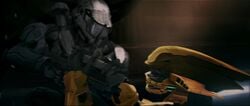
The Covenant refer to the UNSC's Spartans as "demons," and regard them with a mixture of contempt and superstitious fear.[10][11][12] Low ranking client races such as the Unggoy and Kig-Yar would frequently panic upon engaging Spartans, their numbers and advanced technology providing little benefit in a protracted fight. The same would prove true of the San'Shyuum Hierarchs, despising demons for their blasphemous defiance of the Great Journey, yet fearful of their lives in the presence of one. Mgalekgolo[citation needed] and Yanme'e were unaffected by the presence of a SPARTAN, as their drastically different nervous systems left them incapable of feeling fear. Sangheili held a more spiteful, begrudging opinion of demons, incredulous that unworthy "vermin" could be the cause of so much havoc. Often, Sangheili or Jiralhanae would disregard tactics and hurl themselves at demons, fighting for the honor of the kill. However such impromptu duels usually resulted in the deaths of the challengers, not the demons. However, after the Great Schism a few Sangheili came to admire the prowess and courage of these warriors, though such views remained rare. Orbital Drop Shock Troopers have been referred to as "imps" in much the same way. The term has also been applied to the renegade Arbiter Fal 'Chavamee. [13]
It is a common superstition among the Sangheili that SPARTANs are reanimated soldiers killed in battle, brought back to life through artificial means to fight again. [14]
Amongst the Covenant, John-117, otherwise known as the Master Chief, the SPARTANs' de facto commander gained the title of The Demon from the Covenant, setting him aside from the rest of the SPARTANs. This came from his destruction of Installation 04. According to Arbiter Thel 'Vadam, this was done as an insult but also with a modicum of respect, showing that even the Covenant, while fearing and insulting their most hated enemy, also had a level of respect for him and his skills as well. Indeed, 'Vadam himself displayed a level of respect for the Master Chief after the events of Halo 2: while they came close to fighting at the beginning of Halo 3 and didn't like each other, Thel worked side by side with his old enemy. Thel continued to refer to him as the Demon even while fighting with him, but showed more respect later, changing to calling him "Spartan" instead.
Even after the Covenant War's conclusion, the nickname "demon" remains emblazoned on the Spartan operatives. Atriox, leader of the Banished, referred to the members of Red Team as "little demons" after he single-handedly defeated Douglas-042, forcing Alice-130 and Jerome-092 to retreat.[15]
Known Scriptures
The San'Shyuum kept written Psalms which expressed the Covenant's faith on the Forerunners and the Great Journey. Only the Psalms listed by the Minister of Discovery are known.[16]
Members of the religion
Sangheili
The Sangheili were once the most devout believers in the San'Shyuum's vision. However, the events at Installation 05 and the Sangheili's replacement by the Jiralhanae muddied the former's belief in the San'Shyuum and in the Great Journey. After the betrayal of the Sangheili was made known, the Sangheili became enraged and opposed the leadership of the High Prophets, subsequently leading to the Great Schism. By 2559, some Sangheili continue to revere the Forerunners as gods, though they do not consider the San'Shyuum to be the gods' messengers.[17] The Servants of Abiding Truth, an ancient Sangheili fundamentalist order, continues to engage in worship of the Forerunners.
Jiralhanae
The latest addition to the Covenant Hegemony, the Jiralhanae at the time of their inception were largely disorganized and were essentially barbarians without any known belief system. The San'Shyuum sought to improve the species by associating them closely with the hierarchy figures, enabling them to embrace the Covenant religion with ease. For the most part, the Jiralhanae were blindly loyal to the San'Shyuum, obeying every command.
Unggoy
Many Unggoy care little for religion, as they were forced into the Covenant, but those that do stayed loyal to the San'Shyuum during the Great Schism.
As a species, their opinions may be split; while many of the Unggoy that Dadab attempts to sermon to are too unintelligent to give any thought to religious matters, the fact that at least some Unggoy are shown to hold mass prayer sessions lasting up to an hour or more as well as Dadab's adopted role of a preacher in itself is testament to the fact that a large number of Unggoy are active believers.
Kig-Yar
The Kig-Yar served more as hired mercenaries than true believers, but still remained with the San'Shyuum during the Great Schism. Their religious beliefs are unknown, but their loyalty to the San'Shyuum is unquestionable, though this is more likely because they wished to be on the side of the more powerful faction. This choice later proved to be an unwise decision.
Others
Likewise, Yanme'e and Lekgolo seem to feel no need for religion in their societies, but continued to follow the Prophets. As a result of their hive-minded lifestyle, the Yanme'e obeyed the San'Shyuum without thought or question. Individual beliefs may have played a part in the Lekgolo's decision, but they may have sided with the Prophets for the same reason as the Kig-Yar, if not for beliefs. At least some Lekgolo have sided with the Sangheili in their opposition, however.
As artificial sentient nanomechanical organisms, Huragok were created by the Forerunners. They have no interest in religion, preferring to focus their attentions onto the technology they are responsible for. Even prior to the Great Schism, Huragok seemed to remain neutral in any fights, one even going as far as to create a gift symbolizing peace for the humans and helping the humans escape. Some Yonhet such as Axl have continued to display strong devotion to the Great Journey even after the fall of the Covenant Empire.
Trivia
- On Installation 00, a Terminal left behind by the Forerunners uses "Great Journey" as a translation for the exile undertaken by the surviving Forerunners after the firing of the Halo Array.[18] Through similar records on other Forerunner installations, the Covenant may have learned of the name and used it to apply to their religion in yet another case of misinterpretation.
- The fall of the Covenant period can perhaps be understood as somewhat being akin the Protestant Reformation in Western Christianity. A loss of faith in a society's religious leaders did not lead to a complete abandonment of said religion's deities. Rather it led to a period of intense conflict as various factions began to develop their own new interpretations of ancient beliefs. Although the Sangheili no longer believed in the Prophets as the messengers of the gods or in the Great Journey as they had described it, many still believed in their gods.
- The superstition that "Demons" are actually dead soldiers reanimated by artificial means is reminiscent of the battleroids, including the player character from the Marathon trilogy. Battleroids are brought back from the dead to serve as physically and technologically augmented supersoldiers.
Gallery
A mural inside the Elder Council Chamber on Sanghelios representing the Covenant's worship of the Forerunners.
Another mural representing the Covenant's worship of the Forerunner Dreadnought.
Sources
- ^ a b Halo 2, campaign level Regret
- ^ Halo: Broken Circle, page 304
- ^ Halo 2, cinematics
- ^ a b Halo: Evolutions - Essential Tales of the Halo Universe, "The Return", pages 506-507
- ^ Halo: Evolutions - Essential Tales of the Halo Universe, "The Return", page 489
- ^ Halo Evolutions - Essential Tales of the Halo Universe volume II, page 299
- ^ Halo: The Flood, "Priority Broadcast Log/Eleventh Cycle, Third Unit", page 365 (2010 edition)
- ^ Halo: The Flood, "Priority Broadcast Log/Eleventh Cycle, Third Unit", pages 366-368 (2010 edition)
- ^ Halo 2: Anniversary, Prologue
- ^ Halo: Ghosts of Onyx, page 243 ("Voro strained to isolate the human word for demons from their objectionable speech... Spartans".)
- ^ Halo: Ghosts of Onyx, page 349 ("They would take no chances with these human demons, these 'Spartans' ".)
- ^ Halo: Ghosts of Onyx, page 372 ("The Fleet Master Elite snarled at Kurt, and the translation filtered through his helmet's speaker: 'One last fight, demon' ".)
- ^ Halo Legends, The Duel, (Unnamed Unggoy: "He's the Demon!")
- ^ Halo: Glasslands
- ^ Halo Wars 2, campaign level, The Signal
- ^ Halo: Evolutions - Essential Tales of the Halo Universe, Wages of Sin
- ^ Halo: Evolutions - Essential Tales of the Halo Universe, The Return
- ^ Halo 3, Terminal 7



